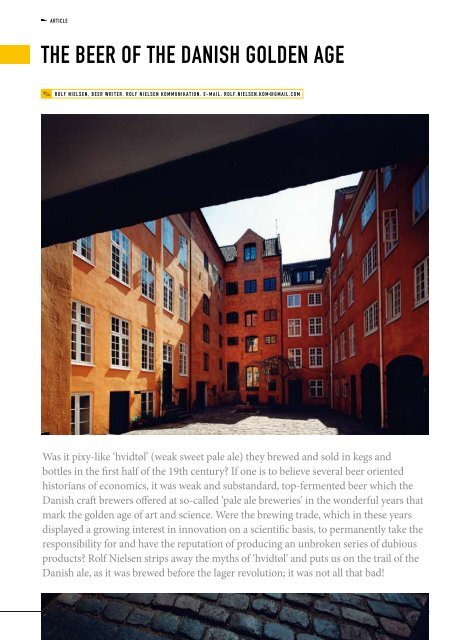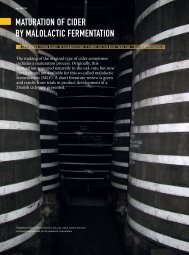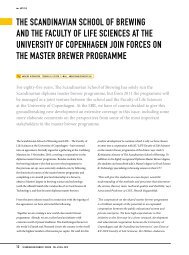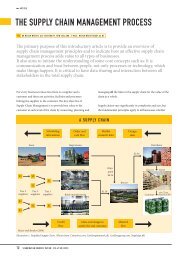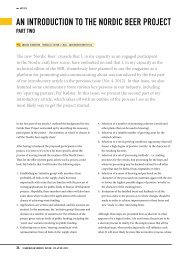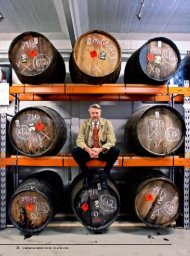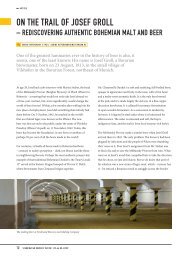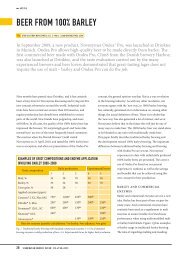The beer of The Danish GolDen aGe - Scandbrewrev.dk
The beer of The Danish GolDen aGe - Scandbrewrev.dk
The beer of The Danish GolDen aGe - Scandbrewrev.dk
You also want an ePaper? Increase the reach of your titles
YUMPU automatically turns print PDFs into web optimized ePapers that Google loves.
arTicle<br />
<strong>The</strong> <strong>beer</strong> <strong>of</strong> <strong>The</strong> <strong>Danish</strong> <strong>GolDen</strong> <strong>aGe</strong><br />
r o l f n i e l s e n , b e e r w r i T e r , r o l f n i e l s e n K o m m u n i K a T i o n . e - m a i l : r o l f . n i e l s e n . K o m @ G m a i l . c o m<br />
Was it pixy-like ‘hvidtøl’ (weak sweet pale ale) they brewed and sold in kegs and<br />
bottles in the first half <strong>of</strong> the 19th century? If one is to believe several <strong>beer</strong> oriented<br />
historians <strong>of</strong> economics, it was weak and substandard, top-fermented <strong>beer</strong> which the<br />
<strong>Danish</strong> craft brewers <strong>of</strong>fered at so-called ‘pale ale breweries’ in the wonderful years that<br />
mark the golden age <strong>of</strong> art and science. Were the brewing trade, which in these years<br />
displayed a growing interest in innovation on a scientific basis, to permanently take the<br />
responsibility for and have the reputation <strong>of</strong> producing an unbroken series <strong>of</strong> dubious<br />
products? Rolf Nielsen strips away the myths <strong>of</strong> ‘hvidtøl’ and puts us on the trail <strong>of</strong> the<br />
<strong>Danish</strong> ale, as it was brewed before the lager revolution; it was not all that bad!<br />
14 SCANDINAVIAN BREWERS’ REVIEW . VOL.65 NO.4 2008
Throughout the last fifty or, rather, hundred years, we have been<br />
exposed to an indoctrinating campaign in favour <strong>of</strong> the<br />
bottom-fermented lager and at the expense <strong>of</strong> the top-fermented<br />
ale.<br />
When it is claimed that the founder <strong>of</strong> the industrial Carlsberg<br />
took his childhood and adolescence steps in ‘a pale ale brewery’<br />
in Brolæggerstræde (Paver Street), it is a truth with consider-<br />
able modifications.<br />
<strong>The</strong> brewing trade was in the middle <strong>of</strong> an epoch that was<br />
characterised by new liberalistic views, new knowledge, and an<br />
extensive consolidation <strong>of</strong> the craft enterprises; a competitive<br />
challenge which was enhanced by the poor state <strong>of</strong> the market<br />
<strong>of</strong> that age. New and revolutionary methods <strong>of</strong> production<br />
loomed in the horizon. <strong>The</strong> nascent continental industrialisa-<br />
tion would soon attract more people to the cities. We know that<br />
in the mid-19th century, the new age <strong>of</strong> the brewing industry<br />
commenced; resulting in a change <strong>of</strong> nature in the second half<br />
<strong>of</strong> the century both with regard to products, ways <strong>of</strong> produc-<br />
tion, brewing methods, and brewing technology. <strong>The</strong> British<br />
<strong>beer</strong> production was already known for its concentrated mass<br />
production with a widespread use <strong>of</strong> mechanical energy. Here,<br />
the breweries were among the trades that used steam engines at<br />
an early point and to a great extent.<br />
<strong>The</strong> FirsT Trick in <strong>The</strong> economic clash<br />
<strong>The</strong> industrial, capital demanding brewery would, however,<br />
also make its entry on the Continent. But where the British<br />
brewing trade continued to concentrate on top-fermented <strong>beer</strong>,<br />
the continental industrial breweries took the new, hot product<br />
<strong>of</strong> the age, the bottom-fermented lager from Munich, as their<br />
starting point. <strong>The</strong> driving forces behind this development<br />
were: Munich Brewer Gabriel Sedlmayer, Vienna Brewer Anton<br />
Dreher, Copenhagen Brewer J.C. Jacobsen, and Brewer Velten<br />
from Marseille.<br />
From the 1850s, there was a rapid development and the 19th<br />
century’s second phase <strong>of</strong> consolidation began. In this way, the<br />
<strong>Danish</strong> brewing trade developed into a battlefield already in the<br />
19th century.<br />
<strong>The</strong> <strong>beer</strong> <strong>of</strong> <strong>The</strong> <strong>Danish</strong> <strong>GolDen</strong> <strong>aGe</strong><br />
But what do we know about the <strong>Danish</strong> top-fermented ale,<br />
about brewing method and products, just before the bottom-<br />
fermented lager and our country’s industrialisation cracked<br />
a centuries old, local brewing technical history <strong>of</strong> develop-<br />
ment? We do actually know quite a lot, since two coinciding<br />
sources meticulously describe the brewing method and the<br />
physical frames <strong>of</strong> precisely the brewery <strong>of</strong> J.C. Jacobsen’s<br />
father in Brolæggerstræde in the last years <strong>of</strong> the 1820s. In<br />
1828, Christen Anthon Brøndum’s serious guide for brewers,<br />
‘Grundsætningerne for Ølbrygningen samt en Beskrivelse<br />
af den i Kiøbenhavn meest anvendte Bryggemetode’ (<strong>The</strong><br />
Basic Principles <strong>of</strong> the Brewing <strong>of</strong> Beer and an Account <strong>of</strong> the<br />
Most Commonly Used Brewing Method in Copenhagen) was<br />
published; it had a beautiful preface by H.C. Ørsted. One <strong>of</strong><br />
the book’s model breweries is mentioned as Christen Jacobsen’s<br />
brewery in Brolæggerstræde, which he had acquired just two<br />
years previously. As he was an extremely ambitious gentleman,<br />
he immediately produced a reconstruction project which was<br />
scanDinaVian brewers’ reView . Vol.65 no.4 2008 15
<strong>The</strong> <strong>beer</strong> <strong>of</strong> <strong>The</strong> <strong>Danish</strong> <strong>GolDen</strong> <strong>aGe</strong><br />
drawn up on paper by a certain Master Builder Blom. <strong>The</strong>se<br />
detailed drawings, combined with Brøndum’s process descrip-<br />
tions, give an excellent and complete insight into Coopenha-<br />
gen’s golden age <strong>of</strong> ale brewing, at the time where this national<br />
style <strong>of</strong> brewing reached its qualitative culmination. Since<br />
then, the palates <strong>of</strong> the <strong>beer</strong> drinking people <strong>of</strong> Denmark have<br />
been flooded with masses <strong>of</strong> uninspiring imitation brew. For<br />
a long period <strong>of</strong> time, the bottom-fermented, continental <strong>beer</strong><br />
types dominated, but recently the top-fermented ales, inspired<br />
by Belgian, British, and American brews, have provided new<br />
energy to the <strong>Danish</strong> 170-year-old imitation tradition. That<br />
the original <strong>Danish</strong> ale has been type casted as ‘hvidtøl’ is due<br />
to combination <strong>of</strong> several factors:<br />
• <strong>The</strong> introduction <strong>of</strong> taxes on <strong>beer</strong><br />
• An early enthusiasm among brewers for the terms<br />
‘white malt’ and ‘white malt kiln’<br />
• <strong>The</strong> ale breweries’ doubts about the development<br />
• And not least, a number <strong>of</strong> historians’ barely<br />
concealed and political excitement for the <strong>Danish</strong><br />
industrialisation’s influence on the brewing trade and<br />
its bottom-fermented products.<br />
<strong>The</strong> economic VicTor – and <strong>The</strong> myTh oF <strong>The</strong><br />
subsTandard PasT<br />
Why this massive and almost stubborn attempt to equate<br />
the early 19th century top-fermented <strong>beer</strong> with today’s weak<br />
products <strong>of</strong> ‘hvidtøl’ by so many historians? <strong>The</strong> phrase: ‘J.C.<br />
Jacobsen’s father had a pale ale brewery in Brolæggerstræde’,<br />
occurs, as mentioned before, again and again.<br />
<strong>The</strong> only rational explanation must be found in the spirit <strong>of</strong><br />
the time in which the many statements took place. Here, I<br />
16 SCANDINAVIAN BREWERS’ REVIEW . VOL.65 NO.4 2008<br />
naturally mean the long period <strong>of</strong> the 19th century where<br />
the Bavarian <strong>beer</strong> revolution had happened and the<br />
bottom-fermented lager was considered to be at the definitive<br />
top <strong>of</strong> the history <strong>of</strong> <strong>beer</strong>’s league table. On the basis <strong>of</strong><br />
this conviction, when the near historical background for<br />
this universally triumphant <strong>beer</strong> type was to be explained,<br />
being at the same time an outstanding <strong>Danish</strong> export hit in<br />
the apparel <strong>of</strong> Carlsberg’s labels, it was probably tempting,<br />
in spite <strong>of</strong> several historical sources, to belittle the old<br />
types <strong>of</strong> ale and equate them both with the filthy, preindustrial<br />
setting <strong>of</strong> old Copenhagen, on the one hand, and<br />
the product that the top-fermented <strong>Danish</strong> <strong>beer</strong> later had<br />
developed into, on the other hand.<br />
In the 19th century’s early years, they had in reality accomplished<br />
to brew <strong>beer</strong> in a quantity that provided an efficient<br />
utilisation <strong>of</strong> raw materials. <strong>The</strong>y had developed the<br />
kiln technology to a point where a more gently treated and<br />
paler malt gave an increased extract during the brewing<br />
process. <strong>The</strong>oretical knowledge combined with temperature<br />
and extract measurings actually provided the brewer<br />
with a completely new popular scientifically grounded<br />
guarantee <strong>of</strong> rational actions during brewing and fermentation.<br />
<strong>The</strong> myTh oF <strong>The</strong> Weak ale<br />
When being occupied with guessing and making tentative<br />
calculations <strong>of</strong> the strength <strong>of</strong> the historical <strong>Danish</strong> ale,<br />
from the renaissance until the end <strong>of</strong> the 18th century, the<br />
conclusion has been that throughout the years, the <strong>beer</strong><br />
managed to present a large palette <strong>of</strong> alcohol levels, cereal<br />
and kiln specific types <strong>of</strong> malt aromas, levels <strong>of</strong> acidity, and
<strong>of</strong> course a number <strong>of</strong> colour shades depending on the method<br />
<strong>of</strong> drying; both when it left the rural breweries and the large<br />
royal brewhouse in the capital.<br />
Towards the end <strong>of</strong> the 18th century, the <strong>beer</strong> was brewed with<br />
less malt than previously, a completely ‘new’ set <strong>of</strong> original<br />
gravity levels, which was carried through to the first half <strong>of</strong> the<br />
19th century. <strong>The</strong> question is whether the finished <strong>beer</strong> was<br />
weaker than before.<br />
<strong>The</strong> ratio between the amount <strong>of</strong> malt used and the average<br />
final volume <strong>of</strong> cold wort is, however, close to the scales you<br />
find today in large as well as small breweries.<br />
<strong>The</strong> most distinct difference between modern brewing and<br />
the craft brewing <strong>of</strong> the 19th century is that back then, they<br />
generally managed to produce three types <strong>of</strong> ale on the basis<br />
<strong>of</strong> the same batch. <strong>The</strong> reason why the old method <strong>of</strong> brewing<br />
produced several types <strong>of</strong> <strong>beer</strong> must be found in the multi-<br />
split way in which they filtered and separated the wort from<br />
the mash during the brewing. It typically took place over three<br />
stages. <strong>The</strong> first wort produced the <strong>beer</strong> <strong>of</strong> the finest quality,<br />
the second wort produced the <strong>beer</strong> <strong>of</strong> medium quality, and<br />
the third wort produced the <strong>beer</strong> <strong>of</strong> the poorest quality. As the<br />
brewing process became increasingly refined, so did new blends<br />
and, <strong>of</strong> course, new types <strong>of</strong> <strong>beer</strong>. <strong>The</strong> very finest <strong>beer</strong>, which<br />
is still referred to as the double <strong>beer</strong> in the 19th century, was<br />
fermented with the ‘pure wort’ or ‘first wort’. Brøndum reports<br />
that when the brewer produced double <strong>beer</strong>, he was not to boil<br />
the hops in water and thus ‘dilute’ the pure wort with the hop<br />
extract. <strong>The</strong>refore, the hops were to be boiled in a part <strong>of</strong> or all<br />
<strong>of</strong> the pure wort.<br />
And when we have a closer look at the more common quality<br />
<strong>beer</strong> and household <strong>beer</strong>, Brøndum has measured it thoroughly;<br />
both the original gravity, the density <strong>of</strong> the wort, and the final<br />
level <strong>of</strong> alcohol.<br />
He reports that the <strong>Danish</strong> ale was only rarely brewed for<br />
double <strong>beer</strong> or at a density <strong>of</strong> more than 1.04. <strong>The</strong> question is<br />
whether the craft brewer <strong>of</strong> the early 19th century in spite <strong>of</strong> a<br />
‘nice’ density still managed to produce a weak <strong>beer</strong> product, a<br />
weak sweet ale or ‘hvidtøl’, because <strong>of</strong> a poor fermentation proc-<br />
ess. Brøndum delivered the pro<strong>of</strong> <strong>of</strong> the opposite. For instance,<br />
he measured an alcohol <strong>of</strong> 4.86 (approx. 6% ABV) in a <strong>beer</strong><br />
where he had previously measured a density <strong>of</strong> 1.048. Another<br />
<strong>beer</strong> with a density <strong>of</strong> 1.036 had an alcohol level <strong>of</strong> 3.47 (4.34%<br />
ABV). A third test revealed 3.75% <strong>of</strong> alcohol (4.7% ABV) in a<br />
<strong>beer</strong> based on a wort with a density <strong>of</strong> 1.041. <strong>The</strong> tests also ena-<br />
<strong>The</strong> <strong>beer</strong> <strong>of</strong> <strong>The</strong> <strong>Danish</strong> <strong>GolDen</strong> <strong>aGe</strong><br />
scanDinaVian brewers’ reView . Vol.65 no.4 2008 17
<strong>The</strong> <strong>beer</strong> <strong>of</strong> <strong>The</strong> <strong>Danish</strong> <strong>GolDen</strong> <strong>aGe</strong><br />
bled him to deduce a type <strong>of</strong> rule <strong>of</strong> the relationship between<br />
density, extract, and alcohol. His result corresponds quite well<br />
to the knowledge we possess today. He measured the <strong>beer</strong> with<br />
an alcohol percentage <strong>of</strong> 4.86 and a density <strong>of</strong> 1.048 to have an<br />
extract <strong>of</strong> 12 per cent, and the <strong>beer</strong> with an alcohol percentage<br />
<strong>of</strong> 3.47 and a density <strong>of</strong> 1.036 to have an extract <strong>of</strong> 9.5 per cent.<br />
‘On the basis <strong>of</strong> this, one can assume that a little more than one<br />
third per cent alcohol is obtained in the <strong>beer</strong> for each per cent<br />
<strong>of</strong> solids in the wort’. Expressed in slightly more modern terms,<br />
he explained that if one knew the percentage <strong>of</strong> extract in the<br />
wort (what we call original gravity and measure in degrees<br />
Plato), one could operate with a fairly reliable basic ratio be-<br />
tween this and the alcohol percentage <strong>of</strong> the final <strong>beer</strong>. It is still<br />
a rule <strong>of</strong> thumb that roughly one third <strong>of</strong> the extract turns into<br />
alcohol if one does not ‘fiddle’ with the enzymatic processes and<br />
adds ‘funny’ micro-organisms.<br />
Brøndum is <strong>of</strong> the conviction that if one ‘fermented for long<br />
enough and applied enough yeast,’ all sugar would be turned<br />
into carbonic acid and alcohol. However, it would not be a good<br />
idea, he points out, as the <strong>beer</strong> would not get the ‘proper taste’<br />
and would most likely turn sour. He is <strong>of</strong> course right in the<br />
latter, since acetic acid bacteria and other nice micro-organisms<br />
would take over the job from the yeast and throw themselves<br />
at the otherwise unfermentable carbohydrates. Moreover, he<br />
believes that ‘the distiller must strive to obtain as much alcohol<br />
from his mash as he can, whereas the brewer should only strive<br />
to produce a suitable amount <strong>of</strong> alcohol relative to the other<br />
ingredients <strong>of</strong> the <strong>beer</strong>’. An entirely culinary approach to the<br />
<strong>beer</strong>, which brings up the concept ‘flavour balance’ at an early<br />
point in the <strong>Danish</strong> history <strong>of</strong> <strong>beer</strong>.<br />
<strong>The</strong> mysTerious colour blindness<br />
Through history, the <strong>Danish</strong> ales have been provided with<br />
many imaginative, poetic, and technical names. But the two<br />
most commonly applied terms for historical top-fermented<br />
<strong>beer</strong> in our kingdom were quite trivially colour describing:<br />
brown <strong>beer</strong> and white <strong>beer</strong>. <strong>The</strong>se two terms were used as<br />
main categories in order to distinguish between all the brews in<br />
the large stream <strong>of</strong> <strong>Danish</strong> ale.<br />
And here, we have to hold on to our hats! Because it is vital<br />
to know that the brown <strong>beer</strong> could be strong or weak and the<br />
white <strong>beer</strong> could also be strong or weak. ‘White <strong>beer</strong>’ was not,<br />
18 SCANDINAVIAN BREWERS’ REVIEW . VOL.65 NO.4 2008<br />
then, an implicit label for strength, but a practical and logical<br />
identification on a colour chart.<br />
For obvious reasons, the term ‘hvidtøl’ has been a mystery to<br />
many contemporary Danes, and the mystery is still kept alive<br />
on the many <strong>Danish</strong> bottles <strong>of</strong> <strong>beer</strong> that contain weak, dark,<br />
and sweet top-fermented ale. One <strong>of</strong> this world’s many para-<br />
doxes in a <strong>beer</strong> industry which, over the years, has developed<br />
several bad habits semantically.<br />
Why in earth call an extremely dark ale ‘white’? Or even more<br />
stupid: call it a ‘dark white ale’? And utterly stupid: call it a<br />
‘pale white ale’? Mysterious practices which take place when<br />
linguistic colour blindness and a lack <strong>of</strong> historical knowledge<br />
controls the labelling and the marketing <strong>of</strong> the gradually more<br />
rare examples <strong>of</strong> pale top-fermented, tax-free ale.<br />
In order to understand why the brewers’ <strong>of</strong> the 19th century<br />
were so enthusiastic about the term ‘white’, we have to have a<br />
closer look at the period where new techniques within malt-<br />
ing had a revolutionary impact on brewing <strong>beer</strong> in the more<br />
advanced craft breweries. It was precisely at the end <strong>of</strong> the<br />
18th century and in the beginning <strong>of</strong> the 19th century that the<br />
Danes, in general, and the Copenhageners, in particular, had<br />
the opportunity to say goodbye to the brown, <strong>of</strong>ten smoke fla-<br />
voured <strong>beer</strong> and put transparent tumblers <strong>of</strong> considerably paler,
<strong>The</strong> <strong>beer</strong> <strong>of</strong> <strong>The</strong> <strong>Danish</strong> <strong>GolDen</strong> <strong>aGe</strong><br />
or ‘white’, top-fermented <strong>beer</strong> to theirs mouths. A reaction to<br />
the dark and <strong>of</strong>ten smoky ‘brown <strong>beer</strong>’ was well on its way,<br />
although it had made up the production <strong>of</strong> the craft breweries,<br />
large and small alike, in Denmark and the remaining Europe<br />
for centuries. We also find the term ‘brown <strong>beer</strong>’ in parallel<br />
British and German terms: ‘brown ale’ and ‘braun Bier’.<br />
<strong>The</strong> WhiTe malT kilns<br />
<strong>The</strong> white <strong>beer</strong>, with its basis in wind dried malt, has had its ups<br />
and downs throughout the last several centuries.<br />
<strong>The</strong> problem being, first and foremost, the farmers’ primi-<br />
tive way <strong>of</strong> drying the malt in the l<strong>of</strong>t which did not ensure a<br />
reliable durability, neither <strong>of</strong> the malt or <strong>of</strong> the <strong>beer</strong>, and as a<br />
consequence <strong>of</strong> these experiences, the craft brewers generally<br />
developed a fear <strong>of</strong> contact with the white wind malt.<br />
But the technique was about to change and the brewers could<br />
clearly see the advantage <strong>of</strong> using paler malts. <strong>The</strong>y provided<br />
a stronger extract and, consequently, a good base for either<br />
sweeter or stronger <strong>beer</strong>.<br />
When malt is toasted or burned, the sugar turns partly, or com-<br />
pletely, into colour and aroma. In other words, it required less<br />
malt to produce a given amount <strong>of</strong> <strong>beer</strong> if the brewer chose the<br />
pale malt rather than the dark malt.<br />
Around Europe, they had experimented continuously and<br />
a revolutionary drying technology was under development.<br />
Already towards the end <strong>of</strong> the 16th century, malt kilns with an<br />
indirect heating <strong>of</strong> the green malt had been installed in a few<br />
larger European breweries. <strong>The</strong> fire was lit in an oven, a ‘bear’<br />
or a ‘pig’, from where it was led through brick ducts under the<br />
kiln. This technique could ensure a pale malt with more taste<br />
and less acidity than the white, ‘primitive’ wind malt. A pleasant<br />
malt; entirely without the smoke flavour from the old kilns with<br />
the direct influence from the fire.<br />
However, it was not until the end <strong>of</strong> the 18th century that<br />
it became customary to produce kiln dried pale malt in the<br />
breweries <strong>of</strong> Copenhagen. A process requiring that the kilns<br />
were converted into so-called stove kilns which directed heat<br />
and smoke to the chimney through pipes going under the malt<br />
flakes; completely without the direct contact with the malt.<br />
Henceforth, the white malt was considered quality malt. <strong>The</strong>y<br />
were simply proud <strong>of</strong> possessing this new and revolutionary<br />
technology; the so-called white malt kiln. That the stove kiln/<br />
white malt kiln was also used for producing darker types <strong>of</strong><br />
malt is another and rather more paradoxical story. <strong>The</strong> brewers<br />
20 SCANDINAVIAN BREWERS’ REVIEW . VOL.65 NO.4 2008<br />
still produced large quantities <strong>of</strong> brown malt, but now without<br />
the smoke flavour. This was ensured by a high temperature in<br />
the stove kiln or white malt kiln.<br />
When the <strong>Danish</strong> ale breweries were to be compared with the<br />
newly emerged Bavarian <strong>beer</strong> breweries, they had to come up<br />
with a competitive name with a strong image for the good old<br />
type <strong>of</strong> enterprise that made a living out <strong>of</strong> brewing top-<br />
fermented <strong>beer</strong>. <strong>The</strong> term ‘hvidtølsbryggeri’ (pale ale brewery)<br />
was pulled out <strong>of</strong> the hat and was utterly cemented with the<br />
introduction <strong>of</strong> taxes on <strong>beer</strong><br />
When <strong>The</strong> WhiTe ale crePT beloW<br />
<strong>The</strong> Taxable leVel<br />
Levies and taxes get the blame for an awful lot <strong>of</strong> things, and<br />
I will take the liberty to expand the list <strong>of</strong> transgressions<br />
with the sad story <strong>of</strong> the <strong>Danish</strong> ale, which turned itself into<br />
‘white ale’ primarily because <strong>of</strong> the invention <strong>of</strong> taxes on <strong>beer</strong>.<br />
Not because the so-called white ale brewers were burdened<br />
with a tax they had to pay themselves, like the Bavarian <strong>beer</strong><br />
producers, or had to collect from their consumers through a<br />
distinctly higher price on their <strong>beer</strong>. No, the majority <strong>of</strong> the<br />
producers <strong>of</strong> top-fermented <strong>beer</strong> went the other way. <strong>The</strong>y<br />
skipped their previous varieties <strong>of</strong> potent top-fermented <strong>beer</strong><br />
at a large scale in order to focus on the production <strong>of</strong> <strong>beer</strong><br />
with an alcohol percentage somewhere below 2.25 in the<br />
future; in other words, <strong>beer</strong> that would avoid taxation, could<br />
be sold at a low price, and hopefully in large quantities. <strong>The</strong><br />
term ‘tax-free’ has the most enchanting effect on most people.<br />
And just like that the <strong>Danish</strong> ale became qualitatively fixed in<br />
a far too familiar form <strong>of</strong> weak and sweet so-called ‘hvidtøl’.<br />
<strong>The</strong> reason why this somewhat slushy product could compete<br />
with the bottom-fermented and taxed types <strong>of</strong> <strong>beer</strong> was purely<br />
because it was consumed along with nice quantities <strong>of</strong> cheap<br />
spirits. <strong>The</strong> arrival <strong>of</strong> a new tax would alter this <strong>Danish</strong>, newly<br />
popular drinking pattern: an extraordinary large increase <strong>of</strong><br />
the levy on spirits, which was brought into effect 26 March,<br />
1917. <strong>The</strong> consumption <strong>of</strong> the weak <strong>beer</strong>’s alcoholic partner<br />
dropped dramatically after this; from 32 million bottles in<br />
1916 to 2.4 million bottles in 1919. This made room for the<br />
Bavarian <strong>beer</strong> which boomed in reverse proportion with the<br />
decline <strong>of</strong> ‘hvidtøl’ and spirits despite the new and higher lev-<br />
ies on the bottom-fermented types <strong>of</strong> <strong>beer</strong>, also.<br />
A sudden exit for the <strong>Danish</strong> ale which adapted itself increas-<br />
ingly to hospital wards, nurseries, and the like and occasion-
ally dressed in pixy hats and daffodils over the next century.<br />
This happened in the province, and it also happened in one<br />
<strong>of</strong> the proud flagships <strong>of</strong> the <strong>Danish</strong> world <strong>of</strong> brewing, the<br />
ale brewery par excellence, Kongens Bryghus (<strong>The</strong> King’s<br />
Brewhouse).<br />
All in all, in stark contrast to modern times where ale must<br />
be considered the hottest <strong>beer</strong> category in Denmark; fancied<br />
in its many shades by the most progressive fractions <strong>of</strong> the<br />
<strong>beer</strong> people. That is the way things go. In recent years we have<br />
witnessed a true revival <strong>of</strong> the top-fermented <strong>beer</strong>, as worthy<br />
brews <strong>of</strong> ‘ale’, far from the ‘white ale’ <strong>of</strong> the 20th century.<br />
We actually had to go a couple <strong>of</strong> hundred years back in time<br />
in order to find good, detailed, and accurate sources that<br />
understood and described the very <strong>Danish</strong> style <strong>of</strong> brewing,<br />
before it was exposed to domestic Bavarian inspired and com-<br />
petitive initiatives as the start <strong>of</strong> the series <strong>of</strong> <strong>Danish</strong> imitation<br />
brews.<br />
But that does not really make any less <strong>of</strong> our history, since it<br />
was at this point that ale brewing had reached its highest me-<br />
thodical and technologic level in this country. We even stand<br />
before a piece <strong>of</strong> brewing history that is not only <strong>of</strong> interest to<br />
the quite large group <strong>of</strong> generally <strong>beer</strong> interested people, but<br />
certainly also must excite the curiosity <strong>of</strong> the <strong>Danish</strong> micro-<br />
brewers and perhaps serve as inspiration in the efforts to<br />
create a new <strong>Danish</strong> or Scandinavian <strong>beer</strong> identity on a solid<br />
historical basis.<br />
PasT, PresenT, and FuTure<br />
– oF <strong>The</strong> danish ale<br />
Today, the <strong>Danish</strong> <strong>beer</strong> trade has changed its scenography<br />
in a revolutionary way and made room for ale brewing once<br />
more. <strong>The</strong> top-fermented <strong>beer</strong> has recovered its honour at a<br />
couple <strong>of</strong> hundred breweries and in the mouths <strong>of</strong> the <strong>Danish</strong><br />
<strong>beer</strong> consumers; and in several versions even its glory. Foreign<br />
ales are imitated at a large scale, but free-style experimenting<br />
with all kinds <strong>of</strong> ales also takes place. We have been skilled at<br />
imitating the foreign successful brews. We have copied Gose,<br />
Porter, Munich Dunkel, Bock, Pilsner, IPA, Stout, and all sorts<br />
<strong>of</strong> pale, brown, and Belgian flavoured ales. We have brewed<br />
on oat, rice, corn, rye, wheat, and barley. Over 600 brews are<br />
produced today in small and large breweries in Denmark, and<br />
quite many <strong>of</strong> these brews are <strong>of</strong> international style, brewed<br />
on the basis <strong>of</strong> models from the big world: <strong>The</strong> Czech Repub-<br />
lic, Germany, United Kingdom, Belgium, and USA. I would,<br />
<strong>The</strong> <strong>beer</strong> <strong>of</strong> <strong>The</strong> <strong>Danish</strong> <strong>GolDen</strong> <strong>aGe</strong><br />
however, be very pleased if the micro- and macro brewers<br />
<strong>of</strong> today would focus on the <strong>Danish</strong> historical brews for the<br />
purpose <strong>of</strong> producing genuinely <strong>Danish</strong> <strong>beer</strong> as it was brewed<br />
before the imitation wave came surging. <strong>The</strong> old style <strong>of</strong> brew-<br />
ing, flavouring, and storing should be explored thoroughly. Of<br />
particular interest are: a gentle infusion mashing, a separate<br />
multi-step boiling with large quantities <strong>of</strong> preferably stored<br />
hops, fermentation in open vessels, and a final, relatively short<br />
conditioning in new oak barrrels.<br />
scanDinaVian brewers’ reView . Vol.65 no.4 2008 21


